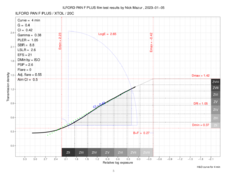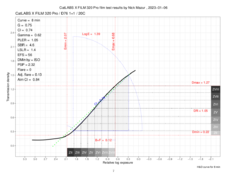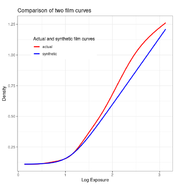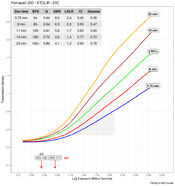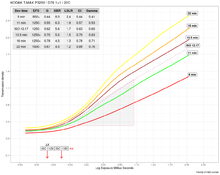Stephen Benskin
Member
I’ve been thinking about writing a post on methodology and the interpretation of a film curve when the thread it was for seems to have stalled. So I’ve decided to start a new thread on the topic instead.
Two of the most useful pieces of information that is generally derived from a film curve are film speed and contrast. I’m going to be addressing contrast. According to Contrast Measurement of Black and White Negative Materials, The British Journal of Photography, May 12, 1967, author either not listed or not copied, “
“Contrast measurements provide a practical guide to the photographer by enabling him to choose a development time for a given film in a given developer which will produce a negative suitable for his particular enlarger on his particular paper grade.”
“There are two basic ways of assessing contrast:
1. By measuring the slope of the straight line portion of the characteristic curve (gamma).
2. By measuring the average slope of the part of the characteristic curve that is most likely to be used in practice.”
While most manufacturers use some form of average gradient today, I believe that taking a look at gamma will help to emphasize the importance of using the method of interpreting a film curve that best comports to reality and real world results. The premise on gamma in C.J. Niederpruem, C.N. Nelson, and J.A.C. Yule, Contrast Index, Photographic Science and Engineering, Vol 10, 1966, is that gamma “is not always an appropriate basis for selecting proper development times for photographic for photographic films. It often fails when applied to films for which the D-log E curve have unusually long or unusually short toes because it does not take into account the fact that a portion of the toe of the curve is normally involved in the exposure of a typical negative.”
Here is how gamma, γ, is derived:

Next is an example of two films. Film B has a longer toe than Film A, but both curves meet at the same point representing the log exposure range of the camera image. This means that while the shape of each curve will produce prints differing in local tone reproduction, the prints will have the same reflection density range, or in other words, both will fit on the same grade of paper. In the example, however, they have different values for gamma.

Taking this as step further, the next example has gamma – time curves and contrast index – time curves (an average gradient method) for a medium toed and long toed emulsion. The development times for two films in the gamma – time curve that will produce films with the same gamma have relatively similar development times. In fact, the gammas are rather closely related throughout development. In stark contract is are the contrast index curves derived from the same family of curves as the gamma – time curve. It shows a far greater difference in development time need to produced negatives with the same contrast index. The paper also includes pictorial examples illustrating the differences.

Among the major film manufacturers, I believe only Agfa uses gamma and it is a modified version at that.
In a following post, I plan on reviewing the different average gradients. The distinction with average gradient comes with determining the best method when taking into consideration conditions differing from the statistical average.
Stephen
Two of the most useful pieces of information that is generally derived from a film curve are film speed and contrast. I’m going to be addressing contrast. According to Contrast Measurement of Black and White Negative Materials, The British Journal of Photography, May 12, 1967, author either not listed or not copied, “
“Contrast measurements provide a practical guide to the photographer by enabling him to choose a development time for a given film in a given developer which will produce a negative suitable for his particular enlarger on his particular paper grade.”
“There are two basic ways of assessing contrast:
1. By measuring the slope of the straight line portion of the characteristic curve (gamma).
2. By measuring the average slope of the part of the characteristic curve that is most likely to be used in practice.”
While most manufacturers use some form of average gradient today, I believe that taking a look at gamma will help to emphasize the importance of using the method of interpreting a film curve that best comports to reality and real world results. The premise on gamma in C.J. Niederpruem, C.N. Nelson, and J.A.C. Yule, Contrast Index, Photographic Science and Engineering, Vol 10, 1966, is that gamma “is not always an appropriate basis for selecting proper development times for photographic for photographic films. It often fails when applied to films for which the D-log E curve have unusually long or unusually short toes because it does not take into account the fact that a portion of the toe of the curve is normally involved in the exposure of a typical negative.”
Here is how gamma, γ, is derived:
Next is an example of two films. Film B has a longer toe than Film A, but both curves meet at the same point representing the log exposure range of the camera image. This means that while the shape of each curve will produce prints differing in local tone reproduction, the prints will have the same reflection density range, or in other words, both will fit on the same grade of paper. In the example, however, they have different values for gamma.
Taking this as step further, the next example has gamma – time curves and contrast index – time curves (an average gradient method) for a medium toed and long toed emulsion. The development times for two films in the gamma – time curve that will produce films with the same gamma have relatively similar development times. In fact, the gammas are rather closely related throughout development. In stark contract is are the contrast index curves derived from the same family of curves as the gamma – time curve. It shows a far greater difference in development time need to produced negatives with the same contrast index. The paper also includes pictorial examples illustrating the differences.
Among the major film manufacturers, I believe only Agfa uses gamma and it is a modified version at that.
In a following post, I plan on reviewing the different average gradients. The distinction with average gradient comes with determining the best method when taking into consideration conditions differing from the statistical average.
Stephen





